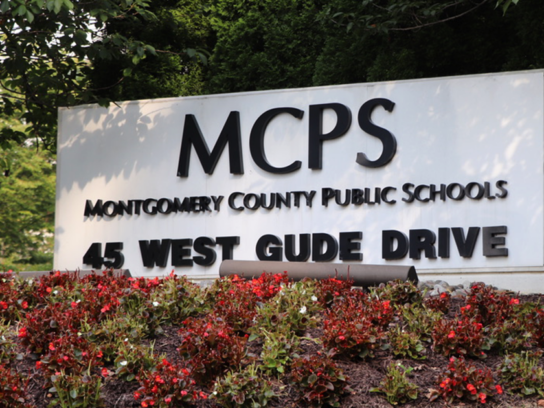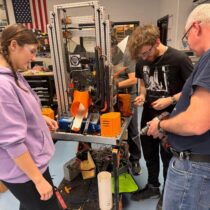
Weeks of debate in Annapolis over the state’s education budget—particularly funding for the Blueprint for Maryland’s Future—have stirred concern over how potential cuts could impact Montgomery County Public Schools (MCPS), especially its most vulnerable students.
The Blueprint for Maryland’s Future is a historic 10-year, $30 billion education reform plan focused on expanding early childhood education, elevating teacher pay and supporting high-poverty schools through community school models.
In the final days of its 90-day legislative session, which ends on April 7, top Democrats and Governor Wes Moore agreed on a “framework” for the state’s budget. However, Maryland lawmakers face more uncertainty over the education budget after learning late last week that $418 million in funds from the Department of Education for public schools may not come, about $300 million of which has already been spent.
Debate surrounding funding to the Blueprint saw students, teachers, advocates and top Democrats push against Moore’s original proposal to cut funding to certain programs under the Blueprint, including community schools. Community schools—those that receive Concentration of Poverty Grants—offer wraparound services like mental health counseling, food pantries, and family engagement supports
Delegate Jheanelle Wilkins, a Montgomery County Democrat representing District 20 and chair of the Legislative Black Caucus of Maryland, said that Montgomery County has the most needs when it comes to English Language learners and students in poverty.
“Montgomery County has 53 community schools, and those are in our highest concentration of poverty schools, and so I was very concerned at the beginning of this session when I saw a budget that cut funding to our community schools, because it was absolutely critical that we continue that work,” Wilkins said.
On March 20, Moore and Democrats agreed to a framework that would bring $1.8 billion in new taxes and revenue, balancing the state’s budget. A week prior, County Executive Marc Elrich proposed a $250 million increase in local funding to MCPS, the largest-ever county contribution, which would include $4 million in additional funding for childcare subsidies and support programs and $1.5 million for Blueprint-required nurses in new community schools.
However, not all councilmembers are on board with Elrich’s budget proposal. Montgomery County Councilmember Andrew Friedson released a statement in early March saying that, though he supports funding schools, he would oppose raising taxes over concerns about the state’s economy.
The Montogomery County Republican Party also said they would mount a petition called “Control MoCo Spending” in an effort to target increasing taxation of county residents. MCGOP Chairman Reardon Sullivan also said in a letter to MCM that the county executive and county council should implement a “lockbox” to make sure money raised for schools is actually used for schools, “and not swept into a general fund.”
“There are lots of recent conversations regarding local funding and state funding and national funding, and what’s going to happen with Department of Education and all these different kinds of things, but it’s really important to remember that the intent of the Blueprint is really to serve our students, to increase their opportunities, to increase their wellbeing and their achievement,” Director of the Division of Blueprint for Maryland’s future in Montgomery County Janine Bacquie said.
Though Bacquie is optimistic about the work the Blueprint enables, like expanded pre-Kindergarten access and bolstered wrap around services for community schools, she said she is also cognizant of concerns regarding funding and how school districts can implement the mandates from the Blueprint while grappling with a statewide teacher shortage.
MCPS has 964 Nationally Board Certified Teachers (NBCTs), the most in the state, an achievement Bacquie credits to the Blueprint, which aims to increase the salaries for NBCTs by $10,000 and by an additional $7,000 for NBCTs in low performing schools.
However, Bacquie also said school districts could do with “a little bit more flexibility” in how some of the guidelines out of the Blueprint are enacted and that a pause could give administrators and educators more time to “look at some other ways that we can help recruit more teachers to come to the state of Maryland.”
“Because Wicomico might do it differently than Talbot, and they might do it differently than Baltimore County, but maybe we’re all getting it done, and the data is showing that we’re successful,” she said.
Montgomery County Board of Education President Julie Yang said in an interview with MCM that the board supports the Blueprint’s goals but also seeks flexibility to address local needs, such as funding for community schools and teacher collaboration time.
“What we are advocating is allowing us to have some flexibility in terms of meeting the goals for the Blueprint,” she said. “We will still be working in all five pillars, and we will still submit plans to be approved to the (Accountability and Implementation Board) to approve yearly, however, if it can allow us to look at different pillars and to see where our greatest need is and to see where our greatest assets is and act accordingly, then we will really appreciate it.”
Yang said the challenges of balancing budget constraints, like the expansion of community schools and the need for additional staff, with the Blueprint’s ambitious goals require collaborative and dynamic problem-solving to get continuous improvement.
“When we work with students, we say we need to have a growth mindset, to have a moving goal post for every student to move forward as an organization,” she said.
“Well, if you want to address a teacher shortage, there are two important ways to do that,” President of the Montgomery County Education Association (MCEA) David Stein said. “One is to enhance salaries, which we are trying to do in this upcoming budget and the other is to improve working conditions.”
The MCEA is a teacher’s union and one of the largest local affiliates of the National Education Association (NEA). Stein was adamant in his support for the funding of the Blueprint stating that improved salaries, planning time and more support for special education students would solve the shortage crisis by enticing educators to work in Maryland.
However, Gordon Brenne of the Montgomery County Taxpayers League does not believe the Blueprint is delivering on what it has promised.
Brenne said the Blueprint was an “unfunded mandate without more state funding” from the state and that implementation of the Blueprint by MCPS was “too top down.”
“The problem isn’t money it’s management,” Brenne said.
Brenne believes that the Blueprint “hasn’t moved the needle” in the four years since its enaction to improve academic performance for students, stating that most money and results go towards elementary schools and ignores middle and high schools. This year, the state’s Education Recovery Scorecard revealed that students are still largely behind their pre-pandemic levels on reading and math, though there has been some improvement in Montgomery County from 2022 to 2024.
Courtney Evans, a parent in Montgomery County of two young children and a member of the Montgomery County PTA, said generally speaking “we have a sturdy ship heading in the right direction” and lauded Superintendent of Schools Dr. Thomas Taylor’s budget proposal. However, she also said she found it difficult to see such a large ask being made that does not include a virtual academy.
“When it’s such a small part of the budget, it was difficult not to see that included again but then I appreciate his approach, and I’m excited for the general direction that we’re heading,” she said.
Praneel Suvarna, a student member of the Montgomery County Board of Education senior at Clarksburg High School, said “extra resources associated with community schools and extra funding provided is a big part of the Blueprint and how we’re funding our students.”
He said certain mandates from the Blueprint make access to higher quality education more accessible to students. Suvarna said this includes financial assistance with AP and IB testing fees and access to dual enrollment. He also stated the benefit for students to see their teachers less stressed due to more collaborative time in community schools. He also noted the benefit to funding extracurricular programs that help foster a more community-based culture.
“We don’t want to be penny wise and pound foolish, right?” he said adding that schools need extracurricular programs that are “maybe not strictly academic,” like sports clubs, but provide “so much buy in for our students and getting them invested in the educational resources that are available in the school.”
He said the COVID-19 pandemic negatively impacted community culture among students and that the effects are still felt today. Suvarna, who will graduate with an associate’s degree from Montgomery College in May and served as class president for the past three years, hopes that the Blueprint will encourage more students to get involved with their community and in turn, care more deeply about their education.
“I would say overall, we’re winning,” Bacquie said. “We have some struggles, we have some challenges, I don’t know what is going to happen with the funding. And that will inevitably impact some of what we are able to do or not do across the state, so those things are concerns. By the end of this session, which is going to happen very soon, we’ll have some more answers.”
As the legislative session nears its end, school leaders, parents, and students across Montgomery County are watching closely. The decisions made in the coming days will not only shape the 2025 budget—but the future of education for thousands of Maryland’s students.

